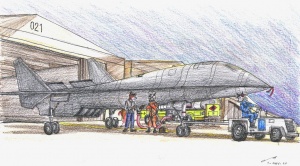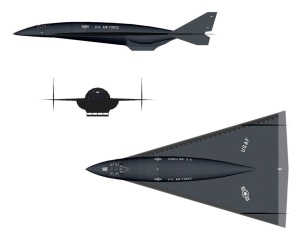SR-91 Aurora
Revision as of 22:03, 5 May 2009 by Lafayette1 (talk | contribs)
| This article may contain original research or unverified claims. Please improve the article by adding references. See the talk page for details. |
| SR-91 "Aurora" | |
|---|---|
| Role | Strategic Reconnaissance Aircraft |
| Manufacturer | Rubin Design Aerospace |
| First flight | 2007 |
| Status | Testing |
| Primary users | U.S. Air Force International Space Agency |
| Produced | 2007 to present |
| Number built | 7 |
| Unit cost | $2.42 billion (approx.) |
| Developed from | SR-71 Blackbird North American X-15 XB-70 Valkyrie |
The Rubin Design SR-91 is an advanced, high-altitude strategic reconnaissance aircraft developed by Rubin Design Defense Systems for use by the United States Air Force. It provides day and night, high-altitude (120,000 feet ASL and above), all-weather surveillance. The aircraft is also being developed for future use in satellite calibration, and satellite data validation.
Contents
History
Design and operational details
Air inlets
Fuselage
Stealth
Fuel
Life support
Sensors and payloads
Operational history
Variants
Popular Culture
Specifications
General characteristics
- Crew: 2 (1 pilot, 1 reconnaissance systems officer)
- Length: 35 m (115 ft)
- Wingspan: 20 m (65 ft)
- Height: 6 m (19 ft)
- Wing area: 300 m² (3,200 ft²)
- Empty weight: 29,480 kg (65,000 lb)
- Max takeoff weight: 71,215 kg (157,000 lb)
- Max takeoff weight: 157,000 lb (71,215 kg)
- Powerplant: 4× Pratt & Whitney J58-1 afterburning turbojets, 32,500 lbf (267 kN est.) each
- High Speed Powerplant: 4× ramjets, scramjets or pulse detonation engines
Performance
- Maximum speed: unknown at sea level (Mach 10 at altitude)
- Range: 9,320 mi (15,000 km)
- Service ceiling: 40,000 m (131,000 ft)
- Thrust/weight: 0.70 est.
Fuel types
- JP-7 or JP-8
- Methane, LH2 or hydrogen fuel cells.
- Possible use of liquid oxygen and hydrogen oxides.
- Possible use of MHD (Magnetohydrodynamics) technology.
Other equipment
- Cameras
- IR sensors
- Other advanced recon sensors

